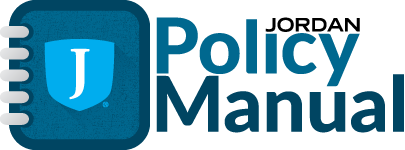- Effective: 7/21/1981
- Revision: 9/8/2009
THIS POLICY ONLY APPLIES TO EMPLOYEES WHO HAVE RETIRED PRIOR TO THE 2006-07 CONTRACT YEAR
- Board Policy
The Board shall provide District administrators an early retirement incentive, and directs the District Administration to administer the program as outlined below.
- Administration Policy
The Administration shall administer the Early Retirement Incentive Program according to the following guidelines:
Guidelines
- An administrator is eligible for this benefit if:
- The administrator has a minimum of ten (10) years full-time equivalent service with the District and, at the time of resignation, retires under the provisions of the Utah Retirement Systems. Years of service will be calculated on the full-time equivalents; i.e., 2 years of half-time service equal 1 year of full-time service.
- The administrator has signed a voluntary early retirement acknowledgment, agreement and waiver to the Age Discrimination in Employment Act (P.L. 101—433) prior to the retirement date of the employee.
- Each year the retiree will receive a percentage of the difference between Lane A, Step 1, of the teachers' C salary schedule and Lane G, Step 25 of the C salary schedule, plus 10 percent of the difference between the administrator's current salary and the amount on Lane G, Step 25, of the teachers' C salary schedule. The percentages shall be based on Jordan District full-time equivalent service as listed in the following table:
| Equivalent Full-time Years |
Percentage of the Difference |
| 10 years |
28% |
| 15 years |
38% |
| 20 years |
48% |
| 25 years |
53% |
| 30 years |
58% |
- This benefit will be paid for a maximum of four (4) years or until the end of the month in which the employee reaches the age for the unreduced Social Security benefit, whichever comes first. An employee retiring during the contract year will be paid monthly commencing the month following the actual retirement date. Employees retiring at the end of the contract year will receive a monthly entitlement commencing with the July 1 pay period.
- FROM the date of retirement until the end of the first fiscal year of the benefit, the retiree has two additional options:
- The retiree may receive the monthly benefit payments in a lump sum. A penalty of 3.25 percent shall be imposed to offset the District's loss in interest earnings.
- The retiree may authorize the District to use the monthly benefit payments to purchase additional service credit for the employee through the State Retirement System. (See Senate Bill 34, passed by the State Legislature in 1995.) A penalty of 3.25 percent shall be imposed to offset the District's loss in interest earnings.
Note: The rate of the penalty shall be examined annually and adjusted as necessary to reflect significant changes in interest rates.
- If death should occur at any point between actual early retirement and the four-year entitlement, a lump sum death benefit payment still due the retiree will be paid to the designated beneficiary (ies). If a retired administrator dies, insurance coverage will continue for eligible dependents according to the schedule outlined in DP319 NEG—Retirement, Licensed.
